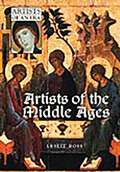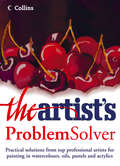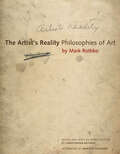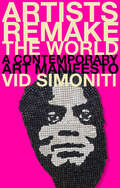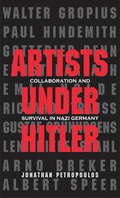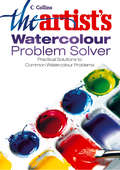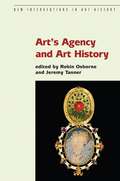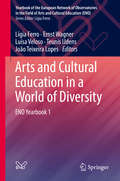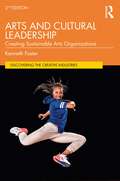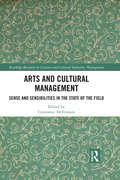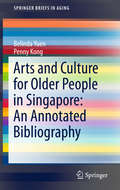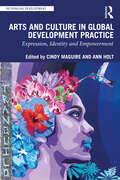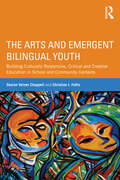- Table View
- List View
Artists of the Middle Ages (Artists of an Era)
by Leslie D. RossIn the first volume of the Artists of an Era series, Leslie Ross examines the identities of artists attributed to the most famous and influential works of medieval art. These works are much discussed within the realm of art history, yet the identities of medieval artists fall victim to incomplete historical records and often remain enigmatic. In ten narrative chapters, Ross examines this significant area of the art world (including architecture, iconography, metalwork, scribework, sculpture—even medieval art instruction) and summarizes the lives and work of that genre's leading artist or artists.Students will learn not only what is factually known of an artist's life (as well as what is purely speculative), but also the processes used to gather the information and fuel speculation. Readers will also gain unique insights into the practices and traditions of medieval art and the role it played within medieval society. A timeline, chapter bibliographies, a list of further resources on medieval art, and an index offer additional tools to students of medieval art and art history.
The Artist’s Problem Solver
by The Artist MagazineThis new ebook edition of the very successful hardback, published in association with The Artist magazine, provides practical solutions to many of the most common painting problems encountered by amateur artists.
The Artist's Reality: Philosophies of Art
by Mark RothkoMark Rothko’s classic book on artistic practice, ideals, and philosophy, now with an expanded introduction and an afterword by Makoto Fujimura Stored in a New York City warehouse for many years after the artist’s death, this extraordinary manuscript by Mark Rothko (1903–1970) was published to great acclaim in 2004. Probably written in 1940 or 1941, it contains Rothko’s ideas on the modern art world, art history, myth, beauty, the challenges of being an artist in society, the true nature of “American art,” and much more. In his introduction, illustrated with examples of Rothko’s work and pages from the manuscript, the artist’s son, Christopher Rothko, describes the discovery of the manuscript and the fascinating process of its initial publication. This edition includes discussion of Rothko’s “Scribble Book” (1932), his notes on teaching art to children, which has received renewed scholarly attention in recent years and provides clues to the genesis of Rothko’s thinking on pedagogy. In an afterword written for this edition, artist and author Makoto Fujimura reflects on how Rothko’s writings offer a “lifeboat” for “art world refugees” and a model for upholding artistic ideals. He considers the transcendent capacity of Rothko’s paintings to express pure ideas and the significance of the decade-long gap between The Artist’s Reality and Rothko’s mature paintings, during which the horrors of the Holocaust and the atomic bomb were unleashed upon the world.
Artists Remake the World: A Contemporary Art Manifesto
by Vid SimonitiAn original and provocative exploration of the relationship between contemporary art, politics, and activism Artists Remake the World introduces readers to the political ambitions of contemporary art in the early twenty-first century and puts forward a new, wide-ranging account of art’s political potential. Surveying such innovations as evidence-driven art, socially engaged art, and ecological art, the book explores how artists have attempted to offer bold solutions to the world’s problems. Vid Simoniti offers original perspectives on contemporary art and its capacity as a force for political and social change. At its best, he argues, contemporary art allows us to imagine utopias and presents us with hard truths, which mainstream political discourse cannot yet articulate. Covering subjects such as climate change, social justice, and global inequality, Simoniti introduces the reader to a host of visionary contemporary artists from across the globe, including Ai Weiwei, Olafur Eliasson, Wangechi Mutu, Naomi Rincón Gallardo, and Hito Steyerl. Offering a philosophy of contemporary art as an experimental branch of politics, the book equips the reader with a new critical apparatus for thinking about political art today.
Artists Under Hitler: Collaboration and Survival in Nazi Germany
by Jonathan Petropoulos“What are we to make of those cultural figures, many with significant international reputations, who tried to find accommodation with the Nazi regime?” Jonathan Petropoulos asks in this exploration of some of the most acute moral questions of the Third Reich. In his nuanced analysis of prominent German artists, architects, composers, film directors, painters, and writers who rejected exile, choosing instead to stay during Germany’s darkest period, Petropoulos shows how individuals variously dealt with the regime’s public opposition to modern art. His findings explode the myth that all modern artists were anti-Nazi and all Nazis anti-modernist. Artists Under Hitler closely examines cases of artists who failed in their attempts to find accommodation with the Nazi regime (Walter Gropius, Paul Hindemith, Gottfried Benn, Ernst Barlach, Emil Nolde) as well as others whose desire for official acceptance was realized (Richard Strauss, Gustaf Gründgens, Leni Riefenstahl, Arno Breker, Albert Speer). Collectively these ten figures illuminate the complex cultural history of Nazi Germany, while individually they provide haunting portraits of people facing excruciating choices and grave moral questions.
The Artist’s Watercolour Problem Solver
by The Artist MagazinePublished in association with The Artist magazine, this superbly illustrated book looks at many of the common problems encountered when using the popular painting medium of watercolour. Twelve well-known professional artists provide practical and straightforward expert solutions.
Artprompts
by Taylor McNeeStuck for something to draw? Want to improve your skills on the widest range of subjects you possibly can? Searching for inspiration for that graphic novel you’ve been planning to start work on forever? Then look no further.
Art's Agency and Art History (New Interventions in Art History)
by Robin Osborne Jeremy TannerArt's Agency and Art History re-articulates the relationship of the anthropology of art to key methodological and theoretical approaches in art history, sociology, and linguistics. Explores important concepts and perspectives in the anthropology of art Includes nine groundbreaking case studies by an internationally renowned group of art historians and art theorists Covers a wide range of periods, including Bronze-Age China, Classical Greece, Rome, and Mayan, as well as the modern Western world Features an introductory essay by leading experts, which helps clarify issues in the field Includes numerous illustrations
Arts and Cultural Education in a World of Diversity: ENO Yearbook 1 (Yearbook of the European Network of Observatories in the Field of Arts and Cultural Education (ENO))
by Lígia Ferro Ernst Wagner Luísa Veloso Teunis IJdens João Teixeira LopesThis volume gathers, analyses, discusses and evaluates results of current research on arts and cultural education in Europe, focusing on the challenges of cultural diversity. Cultural diversity is an increasingly characteristic feature of contemporary societies. Groups with different ethnic, social or cultural backgrounds coexist, interact and merge. The challenges of cultural diversity – its innovative potential as well as tensions and conflicts – are reflected in transnational discourses on education, culture, democracy, and citizenship. Transcultural approaches, multicultural education, and intercultural learning are key concepts. The same challenges are reflected in arts and cultural education within and outside schools, in teachers’ and artists’ training, cultural and educational policies, and research.The thirteen chapters in this book report on nine countries represented in the European Network of Observatories in the Field of Arts and Cultural Education (ENO). They showcase good practices in research and teaching, foster the exchange of experiences, stimulate researchers and stakeholders and give insights into their professional practices.
Arts and Cultural Education in a World of Diversity: ENO Yearbook 1 (Yearbook of the European Network of Observatories in the Field of Arts and Cultural Education (ENO))
by Luísa Veloso Lígia Ferro Ernst Wagner Teunis IJdens João Teixeira LopesThis volume gathers, analyses, discusses and evaluates results of current research on arts and cultural education in Europe, focusing on the challenges of cultural diversity. Cultural diversity is an increasingly characteristic feature of contemporary societies. Groups with different ethnic, social or cultural backgrounds coexist, interact and merge. The challenges of cultural diversity – its innovative potential as well as tensions and conflicts – are reflected in transnational discourses on education, culture, democracy, and citizenship. Transcultural approaches, multicultural education, and intercultural learning are key concepts. The same challenges are reflected in arts and cultural education within and outside schools, in teachers’ and artists’ training, cultural and educational policies, and research.The thirteen chapters in this book report on nine countries represented in the European Network of Observatories in the Field of Arts and Cultural Education (ENO). They showcase good practices in research and teaching, foster the exchange of experiences, stimulate researchers and stakeholders and give insights into their professional practices.
Arts and Cultural Leadership: Creating Sustainable Arts Organizations (Discovering the Creative Industries)
by Kenneth FosterThis textbook provides an expert overview of the challenge of arts and cultural leadership in the contemporary world. Grounded in theories of sustainability and with a renewed global focus for this second edition, the author’s insights from contemporary arts organizations facilitate meaningful student comprehension. Drawing on the work of practitioners and theorists in the fields of philosophy, biology, and ecology as well as the arts, Foster proposes a rethinking of organizational design, strategy, and structure that is based on ecological concepts and the creative process that is intrinsic to the arts rather than the conventional business model that currently prevails, particularly in western arts and culture organizations. He contests conventional thinking about arts administration and management and urges arts leaders to foreground innovation as they reimagine their organizations for a world unlike any other. New sections include an enhanced theoretical discussion as well as new material on business models, strategy, and organizational design and practice. Applicable to any arts organization, the entrepreneurial focus is especially relevant in the aftermath of the global pandemic, the ongoing climate crisis, and the quest for democracy and social justice. This updated edition will be a valuable resource both for present-day arts and cultural leaders who are working to adapt to the current environment as well as students and future leaders who aspire to make change in the world through arts and cultural leadership.
Arts and Cultural Leadership: Creating Sustainable Arts Organizations (Discovering the Creative Industries)
by Kenneth FosterThis textbook provides an expert overview of the challenge of arts and cultural leadership in the contemporary world. Grounded in theories of sustainability and with a renewed global focus for this second edition, the author’s insights from contemporary arts organizations facilitate meaningful student comprehension. Drawing on the work of practitioners and theorists in the fields of philosophy, biology, and ecology as well as the arts, Foster proposes a rethinking of organizational design, strategy, and structure that is based on ecological concepts and the creative process that is intrinsic to the arts rather than the conventional business model that currently prevails, particularly in western arts and culture organizations. He contests conventional thinking about arts administration and management and urges arts leaders to foreground innovation as they reimagine their organizations for a world unlike any other. New sections include an enhanced theoretical discussion as well as new material on business models, strategy, and organizational design and practice. Applicable to any arts organization, the entrepreneurial focus is especially relevant in the aftermath of the global pandemic, the ongoing climate crisis, and the quest for democracy and social justice. This updated edition will be a valuable resource both for present-day arts and cultural leaders who are working to adapt to the current environment as well as students and future leaders who aspire to make change in the world through arts and cultural leadership.
Arts and Cultural Management: Sense and Sensibilities in the State of the Field (Routledge Research in the Creative and Cultural Industries)
by Constance DeVereauxArts and Cultural Management: Sense and Sensibilities in the State of the Field opens a conversation that is much needed for anyone identifying arts management or cultural management as primary areas of research, teaching, or practice. In the evolution of any field arises the need for scrutiny, reflection, and critique, as well as to display the advancements and diversity in approaches and thinking that contribute to a discipline’s forward progression. While no one volume could encompass all that a discipline is or should be, a representational snapshot serves as a valuable benchmark. This book is addressed to those who operate as researchers, scholars, and practitioners of arts and cultural management. Driven by concerns about quality of life, globalization, development of economies, education of youth, the increasing mobility of cultural groups, and many other significant issues of the twenty-first century, governments and individuals have increasingly turned to arts and culture as means of mitigating or resolving tough policy issues. For their growth, arts and culture sectors depend on people in positions of leadership and management who play a significant role in the creation, production, exhibition, dissemination, interpretation, and evaluation of arts and culture experiences for publics and policies. Less than a century old as a formal field of inquiry, however, arts and cultural management has been in flux since its inception. What is arts and cultural management? remains an open question. A comprehensive literature on the discipline, as an object of study, is still developing. This State of the Discipline offers a benchmark for those interested in the evolution and development of arts and cultural management as a branch of knowledge alongside more established disciplines of research and scholarship.
Arts and Cultural Management: Sense and Sensibilities in the State of the Field (Routledge Research in the Creative and Cultural Industries)
by Constance DeVereauxArts and Cultural Management: Sense and Sensibilities in the State of the Field opens a conversation that is much needed for anyone identifying arts management or cultural management as primary areas of research, teaching, or practice. In the evolution of any field arises the need for scrutiny, reflection, and critique, as well as to display the advancements and diversity in approaches and thinking that contribute to a discipline’s forward progression. While no one volume could encompass all that a discipline is or should be, a representational snapshot serves as a valuable benchmark. This book is addressed to those who operate as researchers, scholars, and practitioners of arts and cultural management. Driven by concerns about quality of life, globalization, development of economies, education of youth, the increasing mobility of cultural groups, and many other significant issues of the twenty-first century, governments and individuals have increasingly turned to arts and culture as means of mitigating or resolving tough policy issues. For their growth, arts and culture sectors depend on people in positions of leadership and management who play a significant role in the creation, production, exhibition, dissemination, interpretation, and evaluation of arts and culture experiences for publics and policies. Less than a century old as a formal field of inquiry, however, arts and cultural management has been in flux since its inception. What is arts and cultural management? remains an open question. A comprehensive literature on the discipline, as an object of study, is still developing. This State of the Discipline offers a benchmark for those interested in the evolution and development of arts and cultural management as a branch of knowledge alongside more established disciplines of research and scholarship.
Arts and Culture for Older People in Singapore: An Annotated Bibliography (SpringerBriefs in Aging)
by Belinda Yuen Penny KongThis book combines in a single volume numerous studies concerning the use of arts and culture to enhance quality of life, health and wellbeing among older people, especially in Singapore. The bibliography covers not only research conducted in Singapore (both published and grey literature), but also a global body of work encompassing the Asia-Pacific region, Europe and North America. In addition to the annotated bibliography, the opening chapter introduces the current state of policy, practice and research on arts and culture for older people in Singapore. The book offers a valuable point of reference for all readers interested in the use of artistic and cultural development as creative and non-pharmacological approaches to providing support throughout the ageing process. It will be particularly useful for anyone interested in research advances in participatory arts therapies and recreational activities for older individuals.
Arts and Culture in Global Development Practice: Expression, Identity and Empowerment (Rethinking Development)
by Cindy Maguire and Ann HoltThis book explores the role that arts and culture can play in supporting global international development. The book argues that arts and culture are fundamental to human development and can bring considerable positive results for helping to empower communities and provide new ways of looking at social transformation. Whilst most literature addresses culture in abstract terms, this book focuses on practice-based, collective, community-focused, sustainability-minded, and capacity-building examples of arts and development. The book draws on case studies from around the world, investigating the different ways practitioners are imagining or defining the role of arts and culture in Belize, Canada, China, Ethiopia, Guatemala, India, Kosovo, Malawi, Mexico, Peru, South Africa, Sri Lanka, Taiwan, Thailand, the USA, and Western Sahara refugee camps in Algeria. The book highlights the importance of situated practice, asking what questions or concerns practitioners have and inviting a dialogic sharing of resources and possibilities across different contexts. Seeking to highlight practices and conversations outside normative frameworks of understanding, this book will be a breath of fresh air to practitioners, policy makers, students, and researchers from across the fields of global development, social work, art therapy, and visual and performing arts education.
Arts and Culture in Global Development Practice: Expression, Identity and Empowerment (Rethinking Development)
by Cindy Maguire Ann HoltThis book explores the role that arts and culture can play in supporting global international development. The book argues that arts and culture are fundamental to human development and can bring considerable positive results for helping to empower communities and provide new ways of looking at social transformation. Whilst most literature addresses culture in abstract terms, this book focuses on practice-based, collective, community-focused, sustainability-minded, and capacity-building examples of arts and development. The book draws on case studies from around the world, investigating the different ways practitioners are imagining or defining the role of arts and culture in Belize, Canada, China, Ethiopia, Guatemala, India, Kosovo, Malawi, Mexico, Peru, South Africa, Sri Lanka, Taiwan, Thailand, the USA, and Western Sahara refugee camps in Algeria. The book highlights the importance of situated practice, asking what questions or concerns practitioners have and inviting a dialogic sharing of resources and possibilities across different contexts. Seeking to highlight practices and conversations outside normative frameworks of understanding, this book will be a breath of fresh air to practitioners, policy makers, students, and researchers from across the fields of global development, social work, art therapy, and visual and performing arts education.
The Arts and Emergent Bilingual Youth: Building Culturally Responsive, Critical and Creative Education in School and Community Contexts
by Sharon Verner Chappell Christian J. FaltisThe Arts and Emergent Bilingual Youth offers a critical sociopolitical perspective on working with emerging bilingual youth at the intersection of the arts and language learning. Utilizing research from both arts and language education to explore the ways they work in tandem to contribute to emergent bilingual students’ language and academic development, the book analyzes model arts projects to raise questions about “best practices” for and with marginalized bilingual young people, in terms of relevance to their languages, cultures, and communities as they envision better worlds. A central assumption is that the arts can be especially valuable for contributing to English learning by enabling learners to experience ideas, patterns, and relationship (form) in ways that lead to new knowledge (content). Each chapter features vignettes showcasing current projects with ELL populations both in and out of school and visual art pieces and poems, to prompt reflection on key issues and relevant concepts and theories in the arts and language learning. Taking a stance about language and culture in English learners’ lives, this book shows the intimate connections among art, narrative, and resistance for addressing topics of social injustice.
The Arts and Emergent Bilingual Youth: Building Culturally Responsive, Critical and Creative Education in School and Community Contexts
by Sharon Verner Chappell Christian J. FaltisThe Arts and Emergent Bilingual Youth offers a critical sociopolitical perspective on working with emerging bilingual youth at the intersection of the arts and language learning. Utilizing research from both arts and language education to explore the ways they work in tandem to contribute to emergent bilingual students’ language and academic development, the book analyzes model arts projects to raise questions about “best practices” for and with marginalized bilingual young people, in terms of relevance to their languages, cultures, and communities as they envision better worlds. A central assumption is that the arts can be especially valuable for contributing to English learning by enabling learners to experience ideas, patterns, and relationship (form) in ways that lead to new knowledge (content). Each chapter features vignettes showcasing current projects with ELL populations both in and out of school and visual art pieces and poems, to prompt reflection on key issues and relevant concepts and theories in the arts and language learning. Taking a stance about language and culture in English learners’ lives, this book shows the intimate connections among art, narrative, and resistance for addressing topics of social injustice.
